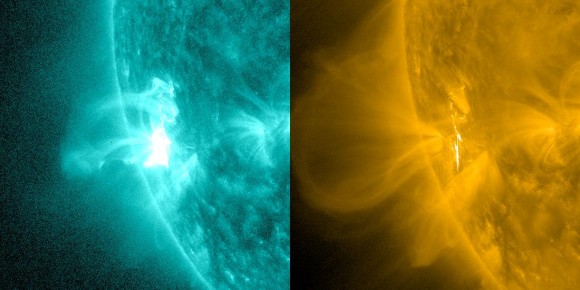On the left, SDO AIA image at the wavelength of 131 angstroms observing the Sun’s atmosphere at a temperature of about ten million degrees. The magnetic rope is seen as the thick looped structure extending above the edge of the Sun.
 On the right, SDO AIA image at wavelength 171 angstroms observing the corona at a temperature of about one million degrees, showing surrounding cool magnetic field lines are pushed away by the intruding magnetic rope seen on the left. Both images are taken almost simultaneously (within three seconds of each other) at 03:41 UT. (Credit: NASA and George Mason University).
On the right, SDO AIA image at wavelength 171 angstroms observing the corona at a temperature of about one million degrees, showing surrounding cool magnetic field lines are pushed away by the intruding magnetic rope seen on the left. Both images are taken almost simultaneously (within three seconds of each other) at 03:41 UT. (Credit: NASA and George Mason University).
It is our current understanding that the Sun’s magnetic fields and field lines are the cause of solar storms However, there is no solid evidence as to what form magnetic field lines may take ahead of an energetic outbreak. We know there can be loops connected to the surface – but normally they take the sting off an eruption, rather than cause one. Thanks to a discovery made by associate professor Jie Zhang and his graduate student Xin Cheng using images from the NASA Solar Dynamics Observatory (SDO) spacecraft, we’re shedding a little light on a solar mystery.
The Astronomical Research Center (A.R.C) mentioned that an event called a magnetic rope is assumed to be the progenitor of solar storms – but its existence was far from certain. The phenomena may consist of many magnetic field lines wrapping around a center axis – possibly twisting around each other – and producing an electric current. The current might then be able to generate enough electromagnetic force to overpower the withholding magnetic field lines and cause the rope to move outward at speeds we so far haven’t been able to document… Until now.
“The magnetic rope triggers a solar eruption. Scientists have been debating whether or not this magnetic rope exists before a solar eruption. I believe that the result of this excellent observation helps finally solve this controversial issue,” says Zhang.
“Understanding the eruption process of these storms will definitely help us better predict them,” says Zhang. “We cannot prevent solar storms, just like we cannot prevent earthquakes or volcanoes. But the development of prediction capacity can help mitigate adverse effects. For instance, satellite operators can power-down key systems to prevent the possible damage to the systems.”